In Scottish and Northern English [1] folklore, a shellycoat is a type of bogeyman that haunts rivers and streams.
In Scottish and Northern English [1] folklore, a shellycoat is a type of bogeyman that haunts rivers and streams.
The name comes from the coat of shells these creatures are said to wear, which rattle upon movement.
Many places on the coast of Scotland have names that reference the shellycoat. Supposedly, shellycoats are particularly fond of the area around the River Hermitage.
Shellycoats are considered to be relatively harmless; they may mislead wanderers, particularly those they think are trespassing upon the creature's territory, but without malice. [2] A common tactic of a shellycoat would be to cry out as if drowning and then laugh at the distracted victim.
As described above, the shellycoat shares many of the traits of the Brag, Kelpie and Nix.
Jacob Grimm stated in his Deutsche Mythologie [3] that the Scottish goblin Shellycoat is one and the same as the German Schellenrock, that is bell-coat:
A pück [home-sprite] served the monks of a Mecklenburg monastery for thirty years, in kitchen, stall and elsewhere; he was thoroughly good-natured, and only bargained for 'tunicam de diversis coloribus, et tintinnabulis plenam.' [a "parti-coloured coat with tinkling bells"] [4] In Scotland there lived a goblin Shellycoat, and we saw (p. 465) that the dwarfs of the Mid. Ages also loved bells [schellen; and schellenkappe is Germ. for cap and bells]. The bells on the dress of a fool still attest his affinity to the shrewd and merry goblin (fol, follet); see Suppl.
Thomas Keightley quotes Grimm and classifies the shellycoat as a type of brownie.: [5]
Another name by which the domestic spirit was known in some parts of Scotland was Shellycoat, of which the origin is uncertain.
The domestic nature of the shellycoat emphasized by Grimm and Keightley stands in contradistinction to the wild nature of the water sprites mentioned in other sources.
In English folklore, The Puck, also known as Goodfellows, are demons or fairies which can be domestic sprites or nature sprites.

A fairy is a type of mythical being or legendary creature, generally described as anthropomorphic, found in the folklore of multiple European cultures, a form of spirit, often with metaphysical, supernatural, or preternatural qualities.

A kobold is a mythical sprite. Having spread into Europe with various spellings including "goblin" and "hobgoblin", and later taking root and stemming from Germanic mythology, the concept survived into modern times in German folklore.
A hobgoblin is a household spirit, appearing in English folklore, once considered helpful, but which since the spread of Christianity has often been considered mischievous. Shakespeare identifies the character of Puck in his A Midsummer Night's Dream as a hobgoblin.

A pixie is a mythical creature of British folklore. Pixies are speculated to be particularly concentrated in the high moorland areas around Devon and Cornwall, suggesting some Celtic origin for the belief and name. However, the word 'pixie' also appears in Dorset, Somerset and to a lesser extent in Sussex, Wiltshire and Hampshire.
Fairies, particularly those of Irish, English, Scottish and Welsh folklore, have been classified in a variety of ways. Classifications – which most often come from scholarly analysis, and may not always accurately reflect local traditions – typically focus on behavior or physical characteristics.
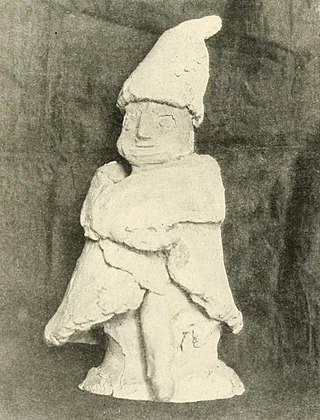
A household deity is a deity or spirit that protects the home, looking after the entire household or certain key members. It has been a common belief in paganism as well as in folklore across many parts of the world.
Thomas Keightley was an Irish writer known for his works on mythology and folklore, particularly Fairy Mythology (1828), later reprinted as The World Guide to Gnomes, Fairies, Elves, and Other Little People.
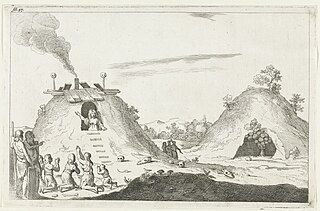
In Dutch mythology and legends, the Witte Wieven are spirits of "wise women". The mythology dates back at least to the pre-Christian era and was known in the present-day regions of the Netherlands, Belgium and parts of France. In some places they were known as Juffers or Joffers ("ladies"), or as Dames Blanches in French.
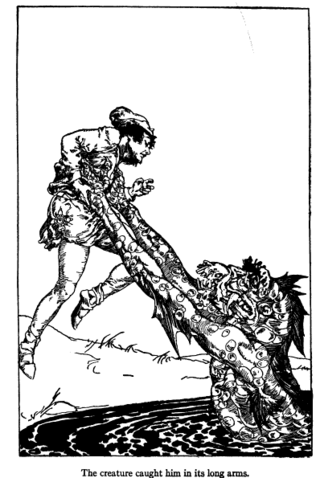
A fuath is a class of malevolent spirits in Scottish Highland folklore, especially water spirits.

"Frau Holle" is a German fairy tale collected by the Brothers Grimm in Children's and Household Tales in 1812. It is of Aarne-Thompson type 480.

A lutin is a type of hobgoblin in French folklore and fairy tales. Female lutins are called lutines.
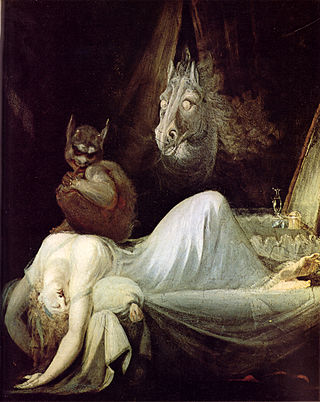
An Alp is a supernatural being in German folklore.

Glashtyn is a legendary creature from Manx folklore.
Deutsche Mythologie is a treatise on Germanic mythology by Jacob Grimm. First published in Germany in 1835, the work is an exhaustive treatment of the subject, tracing the mythology and beliefs of the ancient Germanic peoples from their earliest attestations to their survivals in modern traditions, folktales and popular expressions.
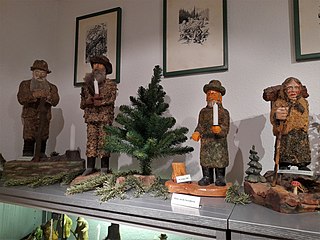
The moss people or moss folk, also referred to as the wood people or wood folk or forest folk, are a class of fairy folk, variously compared to dwarfs, elves, or spirits, described in German folklore as having an intimate connection to trees and the forest. In German, the words Schrat and Waldschrat are also used for a moss person. The diminutive Schrätlein also serves as synonym for a nightmare creature.

In German folklore, the Weiße Frauen are elven-like spirits that may have derived from Germanic paganism in the form of legends of light elves. The Dutch Witte Wieven went at least as far back as the 7th century, and their mistranslation as White Women instead of the original Wise Women can be explained by the Dutch word wit also meaning white. They are described as beautiful and enchanted creatures who appear at noon and can be seen sitting in the sunshine brushing their hair or bathing in a brook. They may be guarding treasure or haunting castles. They entreat mortals to break their spell, but this is always unsuccessful. The mythology dates back at least to the Middle Ages and was known in the present-day area of Germany.

A brownie or broonie (Scots), also known as a brùnaidh or gruagach, is a household spirit or Hobgoblin from Scottish folklore that is said to come out at night while the owners of the house are asleep and perform various chores and farming tasks. The human owners of the house must leave a bowl of milk or cream or some other offering for the brownie, usually by the hearth. Brownies are described as easily offended and will leave their homes forever if they feel they have been insulted or in any way taken advantage of. Brownies are characteristically mischievous and are often said to punish or pull pranks on lazy servants. If angered, they are sometimes said to turn malicious, like boggarts.
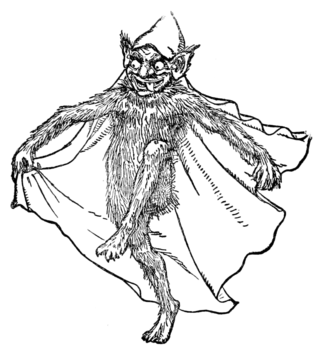
A goblin is a small, grotesque, monstrous creature that appears in the folklore of multiple European cultures. First attested in stories from the Middle Ages, they are ascribed conflicting abilities, temperaments, and appearances depending on the story and country of origin, ranging from mischievous household spirits to malicious, bestial thieves. They often have magical abilities similar to a fairy or demon, such as the ability to shapeshift.